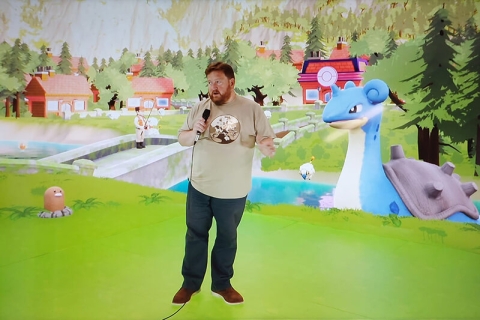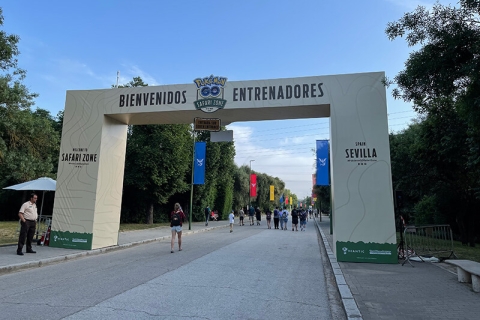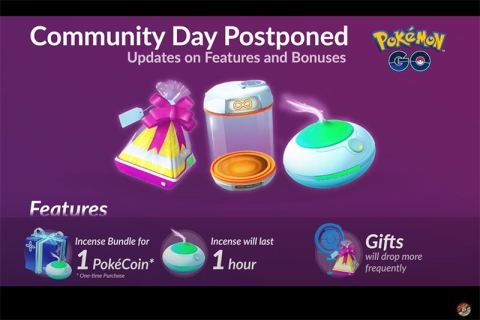

After six years of Pokémon Go, both the game and the fan community have experienced some significant changes
9 min read
This blog is based on ‘Catching a Pokémon in a Pandemic’, a talk presented in the Centre for Creative and Immersive Extended Reality (CCIXR) as part of PortsFest on Friday 1 July 2022.

Author discussing Pokémon Go at PortsFest, July 2022.
This month, mobile game Pokémon Go is celebrating its sixth anniversary with a number of events and in-game features. Created by San Francisco-based software company Niantic, the game uses AR technology so players can catch and interact with Pokémon on their mobile phones as they go around their daily business. Niantic started out as a small spin-out company from Google, using the latest tech to launch mobile app games that encouraged exploration, social interaction and immersion. Pokémon Go is based on the hugely successful Japanese trading card and computer games, TV, and film franchise, but unlike its predecessors, it was marketed around the message: go out, explore your local area, and catch Pokémon that hide around you. The app also encouraged health and fitness, finding new points of local and historic interest, meeting new friends, and joining a community to play together.
Successful Beginnings
As I have written previously, the game was an instant success with millions of players signing up in the first year and having since made over $6 billion in profit. Despite an inevitable drop-off in players, the app has been downloaded over a billion times. Unsurprisingly, it was so popular on launch that game servers could not cope and thus gameplay did not live up to the initial promise. However, the hype was there. The key ideas of community, exploration and developing new technology helped promote its popularity – people were genuinely interested in seeing what was possible on their phones. On top of this, familiarity with the Pokémon franchise built over the past 25 years created a certain sense of nostalgia, which is fundamental in attracting video game players and other Pokémon fans to Pokémon Go and sustaining its popularity with existing players – especially during and coming out of a global pandemic.
Around the game, a new culture has grown. Player meetups organised through social media and messaging apps like Discord, Facebook, Messenger and WhatsApp brought communities of disparate players together. Niantic encouraged social events like Community Days, ticketed events like Go Fest, and in-game social interaction like friendship and gifting to enhance quality of life and the immersive AR experience. May and July this year saw Niantic host two large in person events in Seville and Berlin, with two more in Seattle and Sapporo to come, all of which have outdoor exploration at their core.

Author discussing Pokémon Go at PortsFest, July 2022.
As with other fandom and gaming communities, a hierarchy has formed – with big name players, professional gamers and content creators making digital material that both promotes the game and their own brands. This means most regular players play through and with either their own local community, their favourite content creators, or a combination of both. We see these relationships most obviously flourish during in person events where fans can meet content creators, or online through YouTube video comments and social media interaction on Twitter. As Pokémon Go evolved, so too has the relationships between Niantic, the content creators, and fans. The impact of the pandemic on these relationships provides a valuable insight into contemporary fan cultures and corporate ownership.
Coping with COVID-19
Just before the COVID-19 pandemic, Niantic had established a popular and successful formula for Pokémon Go that combined in person events, activities and in-game features that were all about social interaction, community and exploration. However, with the national and global restrictions imposed on players during lockdowns and quarantines, Niantic and the game had to change to make sure players didn’t lose interest and could still enjoy the gaming experience. New features allowed for interaction at a distance, bonuses for people who couldn’t leave their houses to walk/hatch eggs, catch Pokémon, or battle other trainers. As outlined in a previous blog, some of these changes inspired fun and original interactions between players and content creators. Because people couldn’t meet outside, social media platforms like Discord, Facebook, Messenger and WhatsApp became online spaces for communities that couldn’t physically meet. Where they were useful before to arrange meetups and in-person activities, the pandemic turned online communities into digital networks of support.

Example of Pokémon Go YouTube content to help players during COVID-19.
The natural consequence of this shift to online meant these platforms became spaces for more than just Pokémon Go related chat. Sharing stories about coping with lockdown, COVID tests, happy tales about shiny Pokémon, and jokes to keep spirits up formed much of the online chatter. Moreover, also talking about bad news like catching COVID, suffering with severe illness, and sometimes the passing of a loved one – even members of the local Portsmouth Pokémon Go community – become vital topics of conversation for people to hear and console about. Content creators had to change focus too – they couldn’t go outside and make YouTube videos or travel to exciting places, so they filmed content in their houses, in their living rooms, in isolation. As a consequence, content became about coping with the pandemic too. However, this wasn’t just about playing the game – for them, it was about preserving revenue streams. With no regular outside YouTube videos uploaded, some content creators turned to live streaming at home, covering game play on platforms like Twitch, or doing less Pokémon Go and going back to more traditional Pokémon content like pulling and rating trading cards.
In-game events that players could play from home were streamed and covered by creators who would interact with their fans in the live chats. A whole new online global community that could play together online through shared groups like Discord emerged thanks to the pandemic. In an unexpected development for Niantic, the pandemic has made Pokémon Go more global than ever, even if you couldn’t leave your house. Some creators shifted so much to online content during the pandemic, seeking alternate revenue streams on Twitch and even the subscription-based Only Fans, that they did less Pokémon Go and eventually stopped making YouTube videos and specific Pokémon Go content altogether. Such drastic change was accelerated by Niantic’s attempts to roll back pandemic bonuses – a move that inspired both fans and content creators alike to protest and use social media to petition the company.
From playing to protesting
#HearUsNiantic trended on Twitter in August 2021, with players all over the world either reducing their game play, in-game purchases or stopping playing altogether. An open letter cowritten by some content creators and a petition signed by millions of fans (including those in Portsmouth) forced Niantic to rethink. Within a month or so, decisions were reversed, most pandemic play was kept – at least until national and global COVID restrictions were lifted. A year on from #HearUsNiantic, the global digital community is still vocal and active. The local in-person communities, such as we see in Portsmouth and all over the world, are still active but perhaps in a more hybrid form. Like so many of us had to work and socialise online during the worst of the pandemic, creating a hybrid work/life balance, the social media communities for Pokémon Go are now just as much about daily life and turmoil as they are about the actual game. However, as more live events happen outside players are organising in person meet ups again. Community Days are regaining popularity and the recent Seville and Berlin ticketed events attracted positive reviews. Yet, changes caused by the pandemic still impact on the community. Those members who left the game left the social media chats, and friends who sadly passed away are still dearly missed.

Player meeting space at the Seville Safari Zone.
Pokémon Go has certainly changed over the six years and, while Niantic are now more than ever encouraging players to go back outside, explore and socialise with friends, local communities remain very much focussed on doing what they find works best for them within their own social groups. COVID-19 had a huge impact on the game and how people played it. It also forced some considerable changes in how people felt about Pokémon Go and Niantic. These changes and feelings still resonate in the community. I foresee that over the next 12 months, while people will return to more in person activity and gameplay, the online communities and interactions will also continue as they provide so much more than the game on its own can offer. The fact that Niantic has just launched its own social app called Campfire which is intended to link players across the world suggests that the company is also looking to create a hybrid community. One that so many players have already done during the pandemic. The latest Niantic effort reminds us that so long as there’s Pokémon to catch out there – players will always find a way to do it that suits them best.

About the author
Lincoln Geraghty is a Professor of Media Cultures in the School of Film, Media and Communication. Expert in fan cultures and practices, he's authored several publications and served as editor and editorial advisor for others. These include Directory of World Cinema, The Journal of Popular Culture, and Reconstruction.
